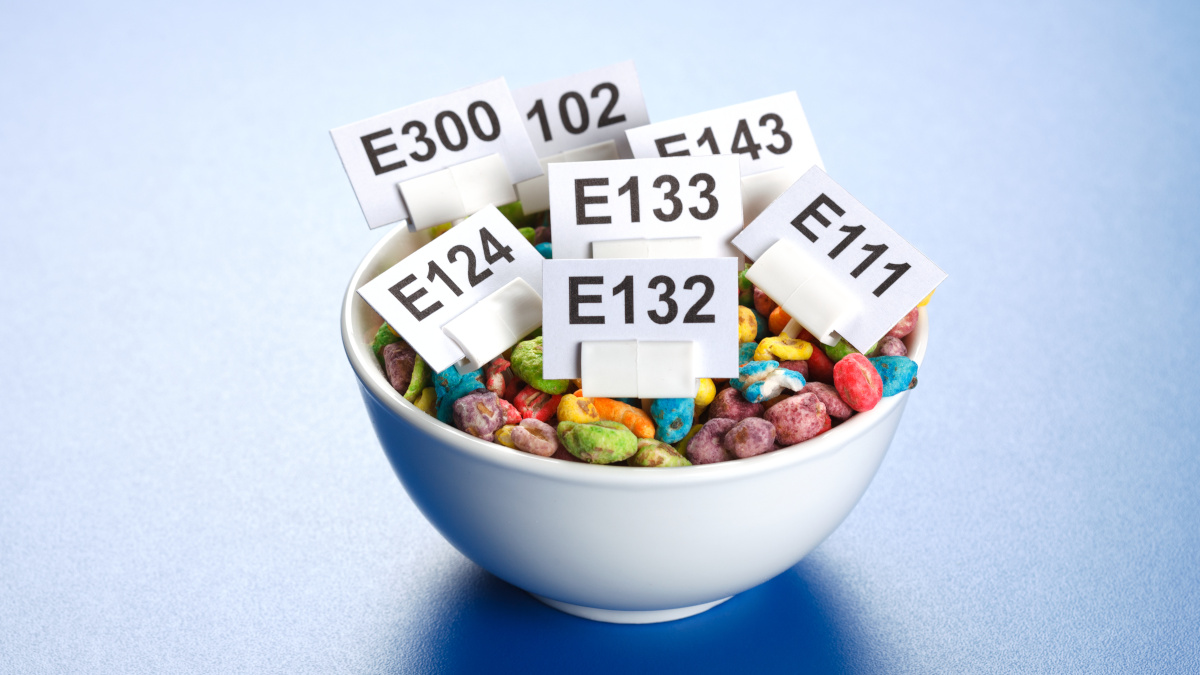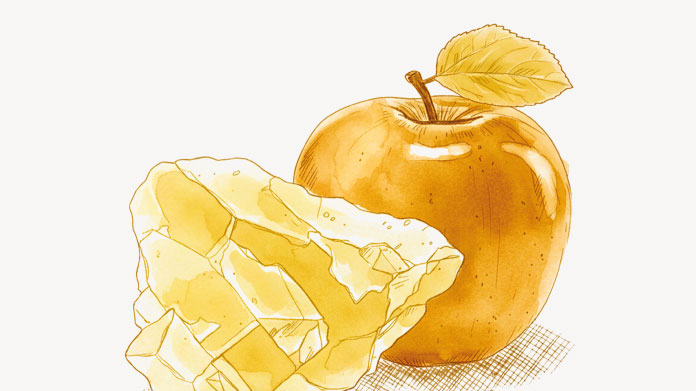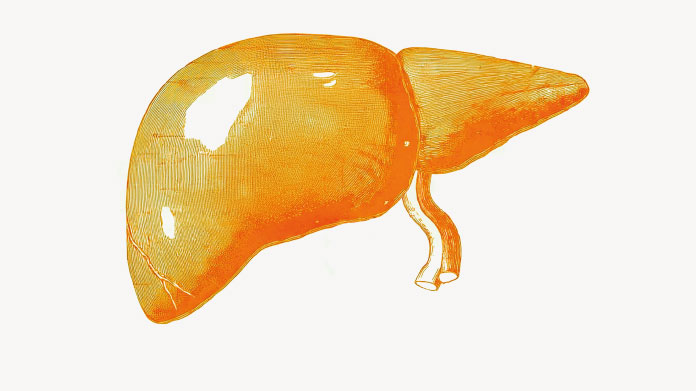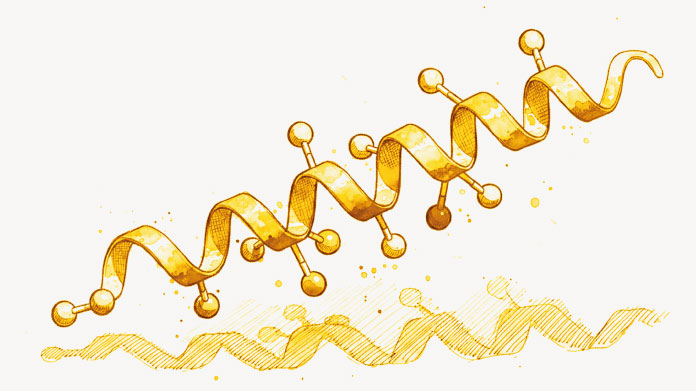Dangerous additives: which food colours and preservatives should you avoid?
Sweets are an obvious example of a product containing food additives – but there’s often nothing ‘sweet’ about these sometimes controversial ingredients. Let’s take a look at the food colours, preservatives and other undesirable substances we’d do well to avoid.

What exactly are food additives?
Food additives are natural or synthetic substancesadded to a product to improve its appearance, texture or preservation. They appear on food labels either as full names or code names (which always begin with the letter E) accompanied by their function in the product.
An example? On your favourite soup packet, glutamate is identifiable by the description ‘flavour-enhancer: monosodium glutamate‘ or ‘flavour-enhancer: E621’.
The European Commission relies on the recommendations of the EFSA (European Food Safety Authority) when deciding whether or not to authorise an additive. Despite an apparently strict framework, the issue of whether additives are completely safe is still contentious: studies are few in number, or they come from manufacturers themselves, there’s inadequate assessment of overlapping ...
What are the main additive groups?
Almost 350 additives are currently authorised for use in Europe. These fall mainly into 5 large groups:
- colours (E100 to E199);
- preservatives (E200 to E299);
- antioxidants (E300 to E399) which stop fats going rancid and fruit turning brown;
- texturizing agents (E400 to E499) which affect a food’s consistency;
- flavour-enhancers (E600 to E699) which strengthen a product’s taste.
Dangerous food additives: which ones should you definitely avoid?
Rest assured that the word ‘additive’ is not necessarily synonymous with ‘harmful’. Some additives protect our food from dangerous bacterial growth. Unfortunately, manufacturers sometimes use them for less positive reasons: to mask poor flavour, add weight to a product through water retention, or create fantastically-artificial colours… So let’s review which ones have received the most criticism so that we can give them a wide berth!
Day glow-coloured ice cream and gummy bears? That’s the work of the ‘Azo’ colours! Including Tartrazine (E102), Quinoline Yellow (E104), Sunset Yellow FCF (E110), Azorubine (E122), Ponceau 4R or Cochineal Red A (E124) and Allura Red AC (E129), they insidiously encourage hyperactivity in children (1-2).
Imparting a nice amber hue akin to cheap balsamic vinegar or cola drinks, the caramel colours (E150c and E150d) have a truly negative aspect. Their production generates 4-methylimidazole, a molecule classified as a probable carcinogen by the International Agency for Research on Cancer (IARC) (3).
Banned in France since January 2021, titanium dioxide (E171) is still used in some European countries as a whitening agent in chewing gum. However, it contains nanoparticles which potentially make it carcinogenic (4).
Spanning the numbers E220 to E228, the sulphites are among the best-known allergens (5). They’re hidden in wine, vinegar, mustard, dried fruit and gherkins. More infamous still, the nitrites (E249 to E252) have long been associated with charcuterie: pink ham is pink because of nitrites! But digesting them leads to the formation of nitrosamine, a probable carcinogen according to the IARC (6-7).
Widely used in processed cheese, the phosphatesare problematic because of their phosphorus content, excessive levels of which are harmful to health (8). Be careful too with BHA (E320) and BHT (E321), both potential endocrine disruptors (9).
The emulsifiers E433 (polysorbate 80) and E466 (carboxymethyl cellulose) are not much better: crossing the intestinal barrier, they can potentially cause inflammatory reactions and even auto-immune diseases.
The moreish taste of ready meals? You’ve got glutamate (E620 to E625) to thank for that (10)! Thought to potentially cause neurological problems, it may also interfere with hunger signals (making us unwittingly reach for that second helping …) Caution is needed too when it comes to synthetic sweeteners such asaspartame (E951) (11).
How to restrict your exposure to food colours and preservatives
Without spending hours scrutinising food labels, you can still adopt measures that will protect you as much as possible from toxic food additives:
- eat home-cooked dishes made from raw ingredients;
- try to eat organic (only around 50 additives are authorised in organic food) ;
- steer clear of any processed product containing more than 3 additives to avoid any ‘cocktail’ effect;
- beware of claims of ‘no artificial colours or preservatives’ which sometimes mask other types of additive;
- use nutrition apps to quickly identify dubious substances;
- choose nitrite-free charcuterie.
Plant extracts to combat the effects of additives
As it’s difficult to control your exposure to additives completely, it can be helpful to incorporate certain plant extracts into your everyday routine.
Like sulphites, certain additives may increase the incidence of allergies. Fortunately, a helping hand is available in the form of natural substances such as astragalus (which helps regulate the immune system) and Scots pine (which supports respiratory health) (12). They are helpfully combined in some synergistic supplements (such as Aller Fight, a high-quality formulation which contains spirulina, bromelain, astragalus, butterbur and Scots pine).
Our immunity may also be adversely affected by additives. That was the finding of a 2017 study on rats conducted by scientists at France’s National Institute for Agronomic Research (INRA). The researchers observed a problem with the immune response in the gut, as well as precancerous lesions in the colon, following prolonged exposure to E171. An essential plant from the European pharmacopoeia, echinacea helps the body’s defence system function properly: a valuable ally for countering the E number onslaught! (13) For maximum benefit, choose an organic echinacea extract (such as Immunity Booster, which is also enriched with zinc and vitamin C).
Regularly detoxifying the liver also helps to eliminate accumulated harmful agents. Containing silymarin, milk thistle plays a role in protecting the liver (14). Extract of artichoke leaf, with its high content in cynarin, also helps to maintain a healthy liver (15). You can find all these liver-healthy substances in targeted formulations (such as the supplement Liver Support Formula).
Some supplements are aimed more at kidney health (such as Kidney Detox Formula). Another option to complement your detox is to take extracts of cruciferous vegetables.
References
- Rowe KS, Rowe KJ. Synthetic food coloring and behavior: a dose response effect in a double-blind, placebo-controlled, repeated-measures study. J Pediatr. 1994 Nov;125(5 Pt 1):691-8. doi: 10.1016/s0022-3476(94)70059-1. PMID: 7965420.
- Boris M, Mandel FS. Foods and additives are common causes of the attention deficit hyperactive disorder in children. Ann Allergy. 1994 May;72(5):462-8. PMID: 8179235.
- Chan PC, Hill GD, Kissling GE, Nyska A. Toxicity and carcinogenicity studies of 4-methylimidazole in F344/N rats and B6C3F1 mice. Arch Toxicol. 2008 Jan;82(1):45-53. doi: 10.1007/s00204-007-0222-5. Epub 2007 Jul 10. Erratum in: Arch Toxicol. 2008 Jan;82(1):55. Hills, G D [corrected to Hill, G D]. PMID: 17619857; PMCID: PMC2366200.
- Proquin H, Jetten MJ, Jonkhout MCM, Garduño-Balderas LG, Briedé JJ, de Kok TM, Chirino YI, van Loveren H. Gene expression profiling in colon of mice exposed to food additive titanium dioxide (E171). Food Chem Toxicol. 2018 Jan;111:153-165. doi: 10.1016/j.fct.2017.11.011. Epub 2017 Nov 8. PMID: 29128614.
- Vally H, Misso NL. Adverse reactions to the sulphite additives. Gastroenterol Hepatol Bed Bench. 2012;5(1):16-23.
- Song P, Wu L, Guan W. Dietary Nitrates, Nitrites, and Nitrosamines Intake and the Risk of Gastric Cancer: A Meta-Analysis. Nutrients. 2015;7(12):9872-9895. Published 2015 Dec 1. doi:10.3390/nu7125505
- Dellavalle CT, Xiao Q, Yang G, Shu XO, Aschebrook-Kilfoy B, Zheng W, Lan Li H, Ji BT, Rothman N, Chow WH, Gao YT, Ward MH. Dietary nitrate and nitrite intake and risk of colorectal cancer in the Shanghai Women's Health Study. Int J Cancer. 2014 Jun 15;134(12):2917-26. doi: 10.1002/ijc.28612. Epub 2013 Nov 29. PMID: 24242755; PMCID: PMC3980001.
- Razzaque MS. Phosphate toxicity: new insights into an old problem. Clin Sci (Lond). 2011;120(3):91-97. doi:10.1042/CS20100377
- Pop A, Kiss B, Loghin F. Endocrine disrupting effects of butylated hydroxyanisole (BHA - E320). Clujul Med. 2013;86(1):16-20.
- Niaz K, Zaplatic E, Spoor J. Extensive use of monosodium glutamate: A threat to public health?. EXCLI J. 2018;17:273-278. Published 2018 Mar 19. doi:10.17179/excli2018-1092
- Landrigan PJ, Straif K. Aspartame and cancer - new evidence for causation. Environ Health. 2021 Apr 12;20(1):42. doi: 10.1186/s12940-021-00725-y. PMID: 33845854; PMCID: PMC8042911.
- Qin Q, Niu J, Wang Z, Xu W, Qiao Z, Gu Y. Astragalus embranaceus extract activates immune response in macrophages via heparanase. Molecules. 2012;17(6):7232-7240. Published 2012 Jun 13. doi:10.3390/molecules17067232
- Zhai Z, Liu Y, Wu L, Senchina DS, Wurtele ES, Murphy PA, Kohut ML, Cunnick JE. Enhancement of innate and adaptive immune functions by multiple Echinacea species. J Med Food. 2007 Sep;10(3):423-34. doi: 10.1089/jmf.2006.257. PMID: 17887935; PMCID: PMC2362099.
- Abenavoli L, Capasso R, Milic N, Capasso F. Milk thistle in liver diseases: past, present, future. Phytother Res. 2010 Oct;24(10):1423-32. doi: 10.1002/ptr.3207. PMID: 20564545.
- Panahi Y, Kianpour P, Mohtashami R, Atkin SL, Butler AE, Jafari R, Badeli R, Sahebkar A. Efficacy of artichoke leaf extract in non-alcoholic fatty liver disease: A pilot double-blind randomized controlled trial. Phytother Res. 2018 Jul;32(7):1382-1387. doi: 10.1002/ptr.6073. Epub 20
Keywords
2 Days
Great product
Great product, but still evaluating its effectiveness. Highly recommended. Super efficient delivery.
Chalise
6 Days
Quality products
Quality products , efficient and effective customer service. You can’t ask more
CLaudia
12 Days
Good quality product and customer service.
So far, I'm liking this product, and the customer service was very good.
ELZL
19 Days
The products I use are excel·lent
The products I use are excel·lent
ROSAS Josep Maria
27 Days
Delivery is prompt and I never saw a…
Delivery is prompt and I never saw a quality problem with the manufacturing. It is not possible to assess efficacy on a personal basis, since too many factors come into play. Efficacy can only be assessed statistically with a sufficient number of cases.
Roger De Backer
28 Days
I collaborates with the Supersmart…
I collaborates with the Supersmart more than 10 years. Every thing is going good. Quality of the things is good. Delivery comes in time. Five stars definitely !!!
Oleksiy
28 Days
All good
Simple, frictionless site, easy ordering, good delivery updates and execution.
Chris Robbins
30 Days
I feel better
I feel better
Peter Ammann
30 Days
Prompt delivery
Prompt delivery
JAKUB Radisch
32 Days
My new go-to for top quality supplements!
I am buying more and more of my supplements from this superb, high quality company. Cannot recommend it enough. Plus, excellent customer service with a quick, helpful team and speedy deliveries. Highly recommend Supersmart!
Cecilie H.
35 Days
SUPERSMART WHAT ELSE👍
SUPERSMART WHAT ELSE👍
DIEDERLE Christophe
38 Days
Excellent quality products with…
Excellent quality products with innovative formulas, as someone who has been suffering with acid reflux, these supplements have been lifesavers.
Oriana Moniz
38 Days
high quality supplement!
high quality supplement!
GALANT
39 Days
Good service prompt delivery
Good service prompt delivery
Mrs Marcella Reeves
44 Days
I like your clear explanation
I like your clear explanation. And how to make a choice of products for a specific health problem
Ingrid



